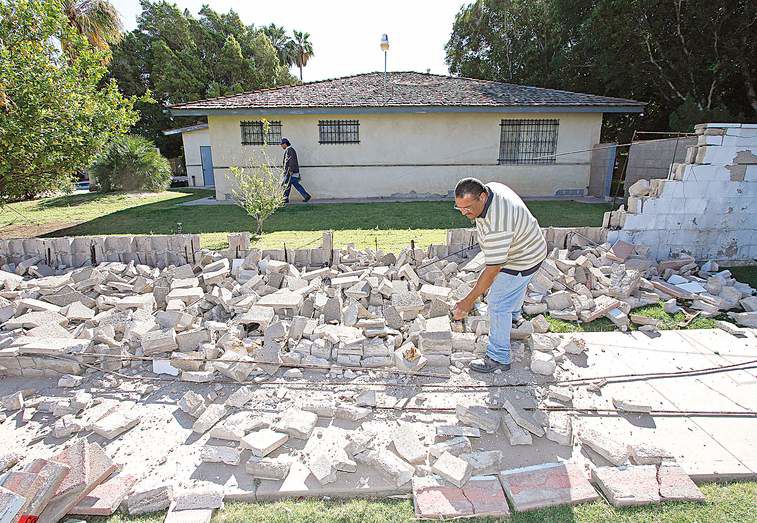There’s a hole in this possible quake pattern
Published 5:00 am Monday, July 26, 2010

- An April earthquake responsible for knocking over a cinder block wall at a home in Calexico, Calif., is one of several recent quakes from which researchers are culling data in hopes of predicting the next big one.
LOS ANGELES — As University of California at Davis physicist and geologist John Rundle ponders the map of recent California earthquakes, he sees visions of a doughnut even Homer Simpson wouldn’t like.
The doughnut is formed by pinpointing the recent quakes in Eureka, Mexicali and Palm Springs.
Seismologists call the possible pattern a Mogi doughnut. It’s the outgrowth of a concept, developed in Japan, which holds that earthquakes occur in a circular pattern over decades — building up to one very large quake in the doughnut hole. Rundle and his colleagues believe that the recent quakes, combined with larger seismic events, including the 1989 Loma Prieta and 1994 Northridge temblors, could be precursors to a far larger rupture.
They just don’t know exactly when.
The idea of predicting earthquakes remains controversial and much debated among California’s many seismologists. But as technology improves and the understanding of how earthquakes distribute energy grows, experts are gingerly offering improved “forecasts,” some of which have been surprisingly prescient.
Checking connections
For example, Southern California was hit earlier this month by a 5.4 quake that struck in the mountains about 30 miles south of Palm Springs — several weeks after seismologists at the Jet Propulsion Laboratory and elsewhere warned that pressure was building in the San Jacinto fault zone, which is where the temblor occurred.
That forecast underscores new thinking by seismologists about how earthquakes occur.
In the past, experts paid less attention to how one fault was connected to another and how one earthquake could increase the chances of a quake on another fault. But now, they believe these connections are extremely important — and this year’s temblors along the Mexican border and near Palm Springs prove the point.
“Previously, we would identify a fault, map it and name it,” said Lisa Grant Ludwig, a UC Irvine earthquake expert. “What we’ve really got here is a network of faults. Maybe that’s what we need to be thinking: more big-picture.”
Seismologists made the forecast about the quake risk south of the Palm Springs area after seeing signs that the 7.2 Mexicali temblor in April had placed more pressure on the San Jacinto fault system, which extends from the border northwest 100 miles toward Riverside and San Bernardino. They were particularly concerned because the San Jacinto fault system connects to the massive 800-mile-long San Andreas fault, which last triggered the “Big One” in Southern California in 1857, leaving a trail of destruction from Central California to the Cajon Pass in the Inland Empire.
David Bowman, a geology professor at Cal State Fullerton, said his research indicates that the Mexicali quake — the largest to strike the region in nearly two decades — was actually triggered by a much smaller quake on an unnamed fault line. The small quake’s energy “jumped on another fault and kept on going,” causing the much larger Mexicali temblor that was felt all the way to Fresno.
“That fault the earthquake started on is so small, we don’t even really know where it is. Yet that small earthquake — that would not have made the news at all — was able to jump onto another fault and become a magnitude 7.2 event,” he said.
The big question is whether the Mexicali quake has made a destructive temblor in the L.A. area more likely. Experts say there’s strong evidence that there is more pressure now on the San Jacinto and nearby Elsinore fault networks to the east of Los Angeles. The Elsinore fault zone is connected to the Whittier fault, which runs through densely populated sections of the L.A. area, including the San Gabriel Valley. As a result, there’s a concern that a quake on the Whittier fault might be more likely.
The Mexicali quake has also turned into a treasure trove of data for earthquake experts. It comes at a time when quake technology has advanced in major ways. Sophisticated satellite images are being used to study creeping ground movement caused by tectonic pressure in advance of an earthquake.
Doughnut theory
New GPS ground monitoring equipment is tracking how far the ground has moved after a quake, allowing scientists to calculate locations of greater seismic stress. And research in the mountains west of Bakersfield, examining the tracks of earthquakes hundreds of years ago, is showing that catastrophic earthquakes — those as large as a magnitude 8 — have occurred in Southern California more frequently than previously believed.
That brings experts back to the Mogi doughnut.
The idea behind the doughnut is relatively straightforward: Earthquakes in California are basically caused by tectonic movements in which the Pacific plate slides northwest relative to the North American plate. As the plates move, stress builds up along both sides of cracks in the Earth’s crust, as if a giant sheet of peanut brittle were being shoved in two directions.
Tectonic stress will first rupture on the smaller faults because they need less pressure before they break and thus produce small earthquakes. When they do rupture, the tectonic pressure gets transferred somewhere else, moving along like a crack in a windshield.
Ultimately, the stress moves closer to bigger faults that need more pressure to erupt, thus creating larger and larger earthquakes until the “Big One” happens.
“It’s a matter of looking at the major earthquakes in California over the last 20, 30, 40 years,” said UC Davis’ Rundle. “They seem to be occurring everywhere except the major faults — the San Andreas, the Elsinore and the San Jacinto.”
Those three faults would be enclosed in Southern California’s doughnut hole. Northern California’s doughnut hole includes the San Andreas and Hayward faults.
The Mogi doughnut hypothesis was developed in 1969 by Japanese seismologist Kiyoo Mogi, who observed a pattern in which smaller earthquakes seemed to precede larger ones.
Experts stress that the Mogi doughnut is still unproven and not universally accepted. Skeptics say the concept could be applied to seemingly random earthquakes.
Whether the doughnut concept proves true, there is a general consensus that California is shaking more than in recent years.








